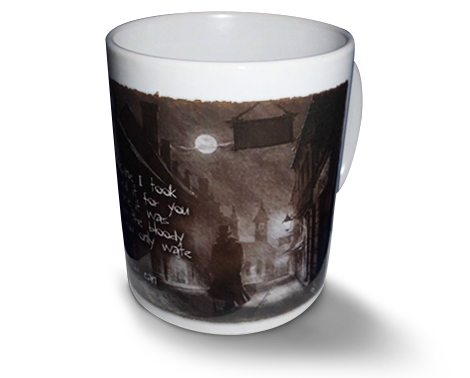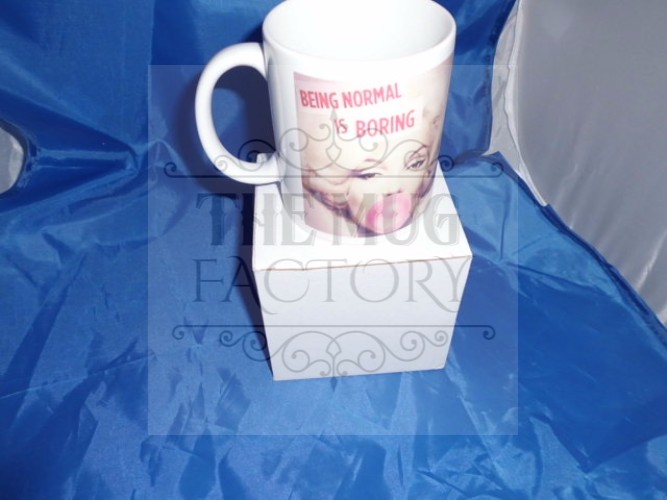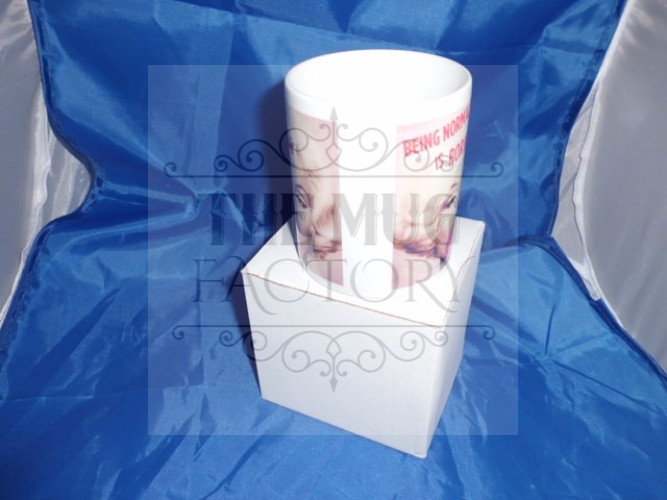Being normal is Boring humorous mug
11oz Being normal is boring
"GIVE A GIRL THE RIGHT SHOES, AND SHE CAN CONQUER THE WORLD."
Marilyn Monroe (born Norma Jeane Mortenson; June 1, 1926 – August 5, 1962) was an American actress and model. Famous for playing comic "dumb blonde" characters, she became one of the most popular sex symbols of the 1950s, emblematic of the era's attitudes towards sexuality. Although she was a top-billed actress for only a decade, her films grossed $200 million by the time of her unexpected death in 1962. She continues to be considered a major popular culture icon.
Born and raised in Los Angeles, Monroe spent most of her childhood in foster homes and an orphanage and married at the age of sixteen. While working in a factory in 1944 as part of the war effort, she was introduced to a photographer from the First Motion Picture Unit and began a successful pin-up modeling career. The work led to short-lived film contracts with Twentieth Century-Fox (1946–47) and Columbia Pictures (1948). After a series of minor film roles, she signed a new contract with Fox in 1951. Over the next two years, she became a popular actress with roles in several comedies, including As Young as You Feel and Monkey Business, and in the dramas Clash by Night and Don't Bother to Knock. Monroe faced a scandal when it was revealed that she had posed for nude photos before becoming a star, but rather than damaging her career, the story resulted in increased interest in her films.
By 1953, Monroe was one of the most marketable Hollywood stars, with leading roles in three films: the noir Niagara, which focused on her sex appeal, and the comedies Gentlemen Prefer Blondes and How to Marry a Millionaire, which established her star image as a "dumb blonde". Although she played a significant role in the creation and management of her public image throughout her career, she was disappointed at being typecast and underpaid by the studio. She was briefly suspended in early 1954 for refusing a film project, but returned to star in one of the biggest box office successes of her career, The Seven Year Itch (1955).
When the studio was still reluctant to change her contract, Monroe founded a film production company in late 1954; she named it Marilyn Monroe Productions (MMP). She dedicated 1955 to building her company and began studying method acting at the Actors Studio. In late 1955, Fox awarded her a new contract, which gave her more control and a larger salary. After a critically acclaimed performance in Bus Stop (1956) and acting in the first independent production of MMP, The Prince and the Showgirl (1957), she won a Golden Globe for Best Actress for Some Like It Hot (1959). Her last completed film was the drama The Misfits (1961).
Monroe's troubled private life received much attention. She struggled with substance abuse, depression, and anxiety. She had two highly publicized marriages, to retired baseball star Joe DiMaggio and playwright Arthur Miller, both of which ended in divorce. She died at the age of 36 on August 5, 1962, from an overdose of barbiturates at her home in Los Angeles. Although Monroe's death was ruled a probable suicide, several conspiracy theories have been proposed in the decades following her death.
In late 1944, Monroe met photographer David Conover, who had been sent by the U.S. Army Air Forces' First Motion Picture Unit (FMPU) to the factory to shoot morale-boosting pictures of female workers. Although none of her pictures were used by the FMPU, she quit working at the factory in January 1945 and began modeling for Conover and his friends. She moved out of her in-laws' home, defying them and her husband, and signed a contract with the Blue Book Model Agency in August 1945. She began to occasionally use the name Jean Norman when working, and had her curly brunette hair straightened and dyed blonde to make her more employable. As her figure was deemed more suitable for pin-up than fashion modeling, she was featured mostly in advertisements and men's magazines. According to the agency's owner, Emmeline Snively, Monroe was one of its most ambitious and hard-working models; by early 1946, she had appeared on 33 magazine covers for publications such as Pageant, U.S. Camera, Laff, and Peek.
Impressed by her success, Snively arranged a contract for Monroe with an acting agency in June 1946. After an unsuccessful interview with producers at Paramount Pictures, she was given a screentest by Ben Lyon, a 20th Century-Fox executive. Head executive Darryl F. Zanuck was unenthusiastic about it, but he was persuaded to give her a standard six-month contract to avoid her being signed by rival studio RKO Pictures. Monroe's contract began in August 1946, and together with Lyon selected the stage name "Marilyn Monroe". The first name was picked by Lyon, who was reminded of Broadway star Marilyn Miller; the last was picked by Monroe after her mother's maiden name. In September 1946, she divorced Dougherty, who was against her having a career.
Monroe during her modeling career
Monroe had no film roles during the first months of her contract and instead dedicated her days to acting, singing and dancing classes. Eager to learn more about the film industry and to promote herself, she also spent time at the studio lot to observe others working.Her contract was renewed in February 1947, and she was soon given her first two film roles: nine lines of dialogue as a waitress in the drama Dangerous Years (1947) and a one-line appearance in the comedy Scudda Hoo! Scudda Hay! (1948). The studio also enrolled her in the Actors' Laboratory Theatre, an acting school teaching the techniques of the Group Theatre; she later stated that it was "my first taste of what real acting in a real drama could be, and I was hooked".Monroe's contract was not renewed in August 1947, and she returned to modelling while also doing occasional odd jobs at the studio.
Determined to make it as an actress, Monroe continued studying at the Actors' Lab, and in October she appeared as a blonde vamp in the short-lived play Glamour Preferred at the Bliss-Hayden Theater, but the production was not reviewed by any major publication. To promote herself, she frequented producers' offices, befriended gossip columnist Sidney Skolsky, and entertained influential male guests at studio functions, a practice she had begun at Fox. She also became a friend and occasional sex partner of Fox executive Joseph M. Schenck, who persuaded his friend Harry Cohn, the head executive of Columbia Pictures, to sign her in March 1948.
Monroe in a studio publicity photo taken when she was a contract player at 20th Century-Fox in 1947. She appeared in two small film roles during the contract and was let go after a year.
While at Fox, her roles had been that of a "girl next door"; at Columbia, she was modeled after Rita Hayworth. Monroe's hairline was raised by electrolysis and her hair was bleached even lighter, to platinum blond. She also began working with the studio's head drama coach, Natasha Lytess, who would remain her mentor until 1955. Her only film at the studio was the low-budget musical Ladies of the Chorus (1948), in which she had her first starring role as a chorus girl who is courted by a wealthy man. During the production, she began an affair with her vocal coach, Fred Karger, who paid to have her slight overbite corrected. Despite the starring role and a subsequent screen test for the lead role in Born Yesterday (1950), Monroe's contract was not renewed. Ladies of the Chorus was released in October and was not a success.
After leaving Columbia in September 1948, Monroe became a protégée of Johnny Hyde, vice president of the William Morris Agency. Hyde began representing her and their relationship soon became sexual, although she refused his proposals of marriage.To advance Monroe's career, he paid for a silicone prosthesis to be implanted in her jaw and possibly for a rhinoplasty, and arranged a bit part in the Marx Brothers film Love Happy (1950). Monroe also continued modelling, and in May 1949 she posed nude for photos taken by Tom Kelley. Although her role in Love Happy was very small, she was chosen to participate in the film's promotional tour in New York that year.
The mugs we use are top quality bright white, Orca coated, and are Dishwasher and Microwave safe, the high quality images are bonded into the surface of the mug, and do not fade or peel off like transfers
GREAT FOR GIFTS, BIRTHDAYS, OR JUST TO ADD TO YOUR MEMORABILIA COLLECTION.
The artwork is created in our offices/workshop, and we are available for custom work. These designs are individually made, not mass produced.
Please note that I take great care in packaging the mugs they are sent in a polystyrene mug box designed to specifically for posting mugs hence the postage costs








